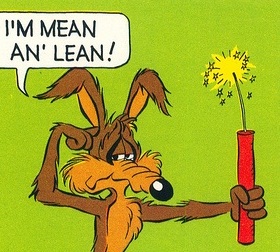|
Science of Muscle Building - A Fistful of Bodybuilding Dynamite Are you training hard enough? The science of muscle building says it only takes one hard hammer blow to make the dynamite go bang. A Fistful of Bodybuilding DynamiteNautilus creator Arthur Jones once likened abbreviated high-intensity training to a hammer and a stick of dynamite. Hitting a stick of dynamite lightly with a hammer will not produce an explosion, no matter how many times you might strike it. If, however, you hit the dynamite very hard, only one hammer blow is enough to stimulate an explosion.
Or in other words, it only takes one hard hammer blow to make the dynamite go bang. Such high-intensity therefore demands a workout that is brief. It demands abbreviated training.
Photo courtesy of Mark Anderson Building Muscle Science...the big bang theoryThe science of muscle building becomes easy to understand when you strip away the 'noise' - indeed, things suddenly become very clear, like fog lifting to reveal a sunny day. To explain: Building muscle science DEMANDS a muscle must first be significantly stressed before it can grow; this stress, for our purposes, takes the form of high-intensity resistance training. An adaptive muscle building response is triggered by this training effect, leading to the enlargement of muscle tissues from the increase in size of its cells (hypertrophy). However, NONE of this can happen before certain favorable conditions are present: i.e., muscle building nutrition and adequate recovery. Building muscle quickly and effectively demands ALL of the above! High Intensity Training ExplosionBecause the toll of high-intensity abbreviated training is so very great, such training should always be approached cautiously. This is why volume and frequency should be monitored at all times to avoid the risk of overtraining. How dangerous is the risk of overtraining? HEAVY DUTY evangelist Mike Mentzer once postulated 99% of bodybuilders FAIL to build muscle due to overtraining. Moreover, Mentzer warned how the standard volume approach to training, rather than triggering muscle growth, actually inhibited the production of muscle mass. Here is what Mentzer had to say about the typical volume approach to training and its inherent dangers: "Overtraining is the biggest mistake you can make, and is literally that which prevents you from realizing increases in strength and muscle size." Mentzer argues: "If VOLUME was the key to triggering muscle growth, then those that train the most would have the largest muscles." In SummaryThe science of muscle building says it only takes one hard hammer blow to make the dynamite go bang. Such high-intensity therefore demands a workout that is brief. It demands abbreviated training. |






